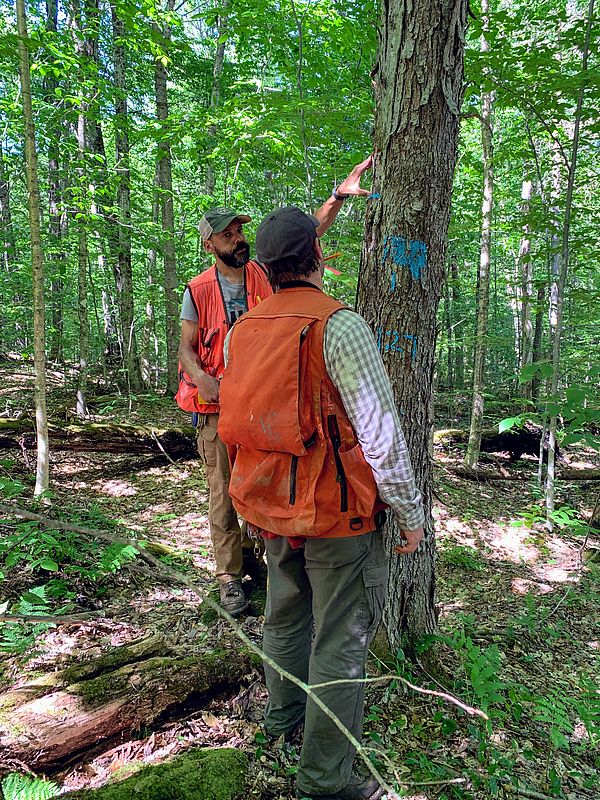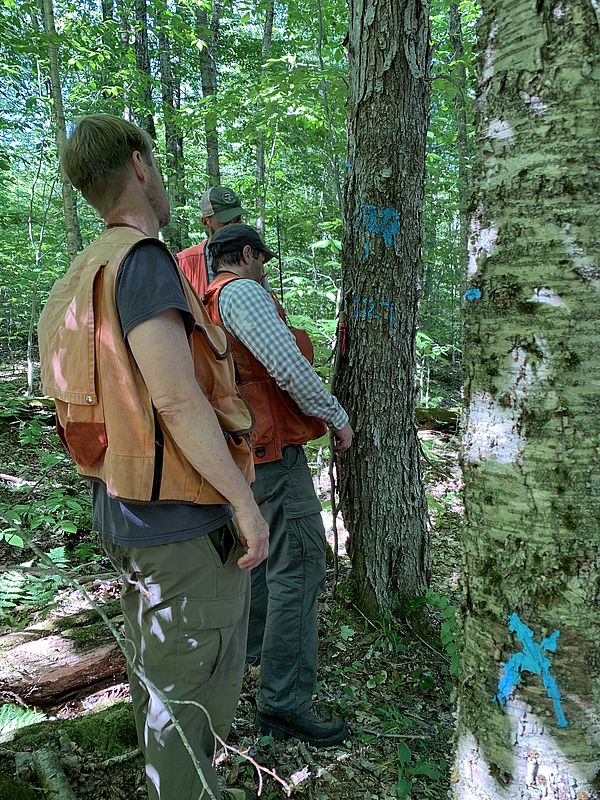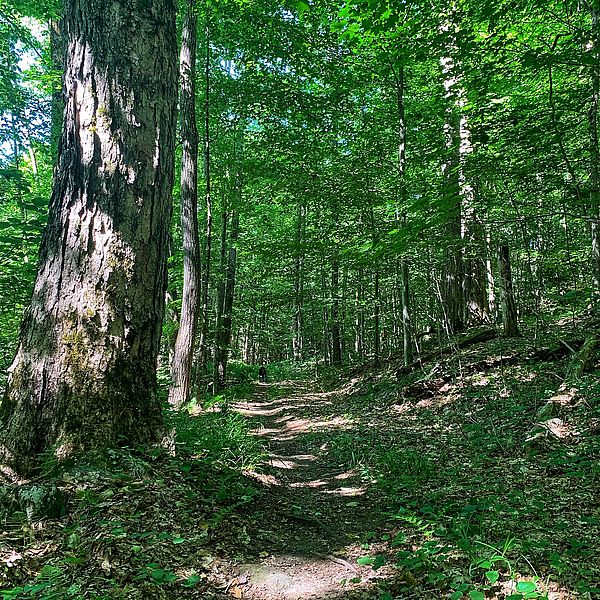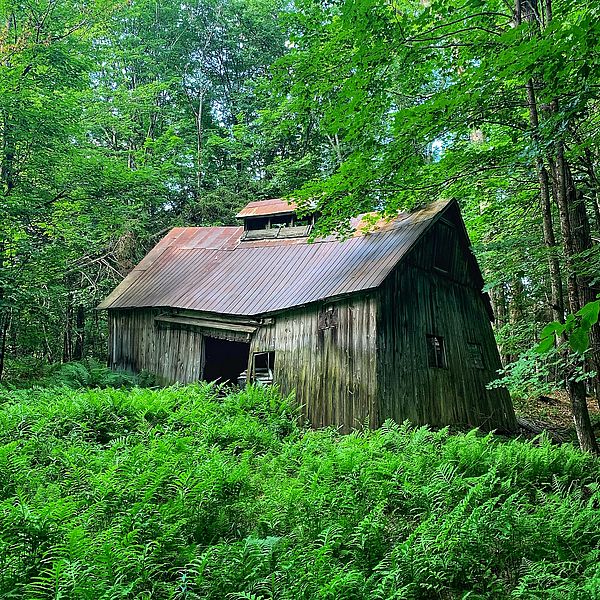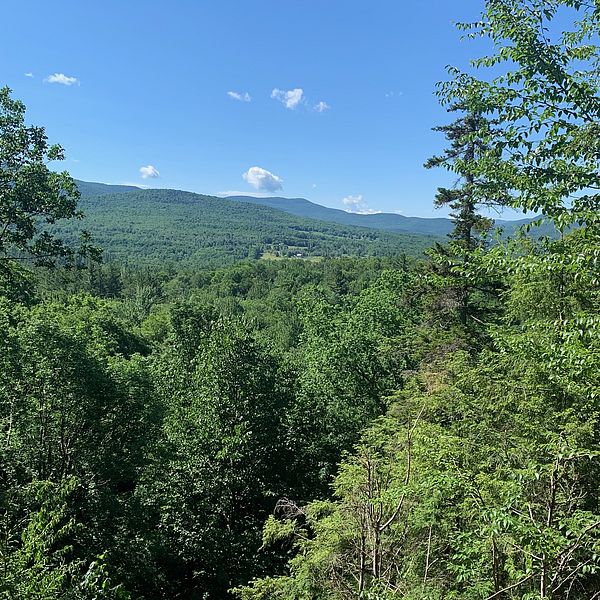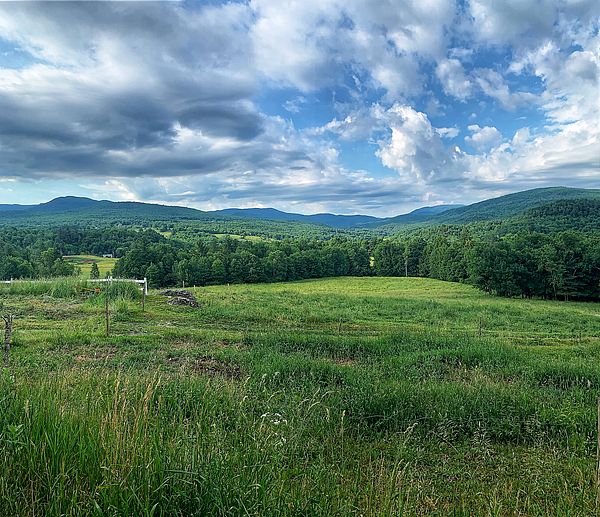As conservationists, tools such as conservation easements are often our most celebrated method to keep forests as forests in perpetuity. However, ensuring that forest ownership remains economically viable is also critical to ensure sound stewardship and the ability for forestland owners to transfer lands to successive generations.
In 2018 the Vermont Land Trust, with funding from the High Meadows Fund and the Vermont Housing and Conservation Board, commissioned a study to examine the feasibility of Vermont landowners selling carbon credits as a means of developing an additional income stream to support the conservation of our forests. The study used real stocking level data from parcels in the Cold Hollow to Canada region, and a subsequent report – Vermont Forest Carbon: A Market Opportunity for Forestland Owners – was completed by the University of Vermont’s Carbon Dynamics Laboratory and the Spatial Informatics Group.
The vast Northern Forest, of which we are a part, stores billions of tons of carbon dioxide, the main driver of global climate change. With over 80% of Vermont’s forests owned by private landowners the decisions they make as stewards have a significant impact both on a local, and global scale. Unfortunately, until now, the sale of carbon credits has been effectively restricted to large single parcels of land in order to overcome the high upfront costs of the initial carbon inventory and continuing verification. The main and exciting takeaway of the Vermont Forest Carbon report was the real opportunity available to landowners at the Vermont scale to aggregate their parcels and participate in the carbon marketplace.
Following on the report, the Vermont Land Trust and Cold Hollow to Canada launched the nation’s first aggregation project – Cold Hollow Carbon – to be advanced to the Voluntary Market under the American Carbon Registry (ACR) standard. Other partners and supporters of the project included the Vermont Housing and Conservation Board, the Land Trust Alliance, the Cotyledon Fund, and the High Meadows Fund. The project brought together 10 landowners in the CHC region across 12 parcels. Between these 10 landowners, the project spanned over 7,500 acres in an agreement which allowed them to enroll in the voluntary carbon market and find buyers for their carbon credits. Businesses, individuals, and institutions purchase the credits to offset emissions that are generated during their course of work or activity. Whereas the Compliance Market (such as we see in California for large scale emitters) is a regulatory tool, the voluntary market is just that—entities making the voluntary decision purchase credits. By working together through this project we were able to break down the barriers of scale and make access to the voluntary market economical for smaller parcels.
At the end of April we learned that as part of its plan to be Net Zero Carbon by 2040, Amazon would be purchasing a large share of the project’s initial credits. Amazon has committed $10 million to restore and conserve four million acres of forest in the Appalachians in partnership with The Nature Conservancy. This investment – of which the Cold Hollow to Canada and Vermont Land Trust project is a part – will help remove over 18 million metric tons of carbon dioxide from the atmosphere (equivalent to 46 billion miles driven by an average passenger vehicle) by helping to steward and conserve family-owned forest lands.
Our hope is that this pilet project serves as a model which can be replicated across our region—not just in Vermont but elsewhere in New England which shares similar land ownership patterns—as a tool to catalyze greater efforts and accelerate the pace of conservation.
What Does Managing for Carbon Mean?
Under the American Carbon Registry protocol, a forest carbon credit is essentially a guarantee that a certain amount of carbon sequestered in a forest, measured at the beginning of each year, will remain in that forest for 40 years. The guarantee is enforced by third party measurement and verification over the 40-year period. This does not mean, however, that no timber can be harvested. Landowners can harvest the growth of timber in excess of this established amount and there are sound silvicultural and economic reasons for doing so. Carbon credits in this project will be generated by maintaining net stable or net increasing stocking (i.e. timber volume) across the project area overall. To achieve this goal, each landowner must schedule timber harvests (i.e. plan the size, type, and timing) to maintain or increase carbon stocks on their property.
A variety of forest management principles and silvicultural approaches can be used to maintain or increase carbon stocks in actively managed forests1. Carbon forestry can accommodate active timber management. But to increase stocking, generally this requires somewhat lighter, smaller, and less frequent harvests compared to intensively managed forests where the primary objective is the yield of wood products. The specific mix of management approaches (ranging, for example, from no-cut zones to more actively managed stands) and silvicultural systems (e.g. uneven-aged, multi-aged, and even-aged) should be developed in consultation with a professional forester. These will need to be stipulated clearly in forest management plans, including those required for enrollment in Vermont’s Current Use Appraisal Program.
A variety of silvicultural guide2 can help inform choice of silvicultural system where multiple objectives are desired, including carbon, timber, wildlife, and others. Generally, these may incorporate elements of the following principles favoring accumulation of carbon storage over time:
- Efficient timber harvest scheduling over time and space to ensure that net annual removals are at or below the net annual carbon stocking increment for a property overall;
- Incorporation of no-harvest or minimal harvests zones, such as riparian buffers and ecologically significant treatment areas;
- Use of extended rotations, where harvest rotations or entry cycles for individual stands are lengthened;
- Use of carefully designed intermediate treatments, such as stand improvement thinning, variable density thinning, and crop tree release methods, that enhance stand quality, health, and growth over time;
- Use of retention practices in regeneration harvests. These practices retain “biological legacies” of all sorts (e.g. live and dead trees, standing and downed material, and soil organic matter) over multiple rotations or entry cycles. A wide variety of retention practices are available for northern hardwood, conifer, and mixed-woods forest types, including modifications of even-aged (e.g. dispersed and aggregated tree retention within harvest units), multi-aged (e.g. irregular shelterwood method), and uneven-aged (e.g. Structural Complexity Enhancement; group or gap-based selection systems with retention). There is no “one-size-fits-all” approach for retention forestry as a means to maintain or enhance carbon stocking. Rather a landowner, working with a professional forester, will want to select the system most appropriate to a given stand, site, and mix of objectives; and
- Use of monitoring data to track changes in stocking over time and to update timber harvest schedules and management plans accordingly.
Want to learn more about forest carbon and its role as a natural climate solution? Check out this great publication by our friends at the University of Vermont and the University of Massachusetts: https://masswoods.org/sites/masswoods.org/files/Forest-Carbon-web_1.pdf
1 Authorship of this section by Keeton & Hancock 2019
2 https://www.fs.fed.us/nrs/pubs/gtr/gtr_nrs132.pdf
https://vt.audubon.org/sites/default/files/silviculture-options_0.pdf
https://www.nnrg.org/wp-content/uploads/2015/03/Franklin_etal_2007_ecoforestry.pdf
